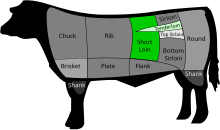T-Bone

Beef Cuts (American terminology)
|
|
| Type | Short loin and tenderloin cut of beef |
|---|---|
The T-bone and porterhouse are steaks of beef cut from the short loin (called the sirloin in Commonwealth countries). Both steaks include a "T-shaped" bone with meat on each side. Porterhouse steaks are cut from the rear end of the short loin and thus include more tenderloin steak, along with (on the other side of the bone) a large strip steak. T-bone steaks are cut closer to the front, and contain a smaller section of tenderloin.
There is little agreement among experts on how large the tenderloin must be to differentiate a T-bone steak from porterhouse. The U.S. Department of Agriculture's Institutional Meat Purchase Specifications state that the tenderloin of a porterhouse must be at least 1.25 inches (32 mm) thick at its widest, while that of a T-bone must be at least 0.5 inches (13 mm). However, steaks with a large tenderloin are often called a "T-bone" in restaurants and steakhouses despite technically being porterhouse.
Owing to their large size and the fact that they contain meat from two of the most prized cuts of beef (the short loin and the tenderloin), T-bone steaks are generally considered one of the highest quality steaks, and prices at steakhouses are accordingly high. Porterhouse steaks are even more highly valued owing to their larger tenderloin.
In the United States, the T-bone has the meat-cutting classification IMPS 1174; the porterhouse is IMPS 1173.
In British usage, followed in Commonwealth countries, porterhouse refers to the strip steak side of a T-bone steak, while the tenderloin side is called the fillet.
The origin of the term "porterhouse" is contentious, with several cities and establishments claiming to have coined it. The Oxford English Dictionary traces the etymology from proprietor Martin Morrison serving large T-bones in his Pearl Street (Manhattan) "Porter House" around 1814, while noting the lack of contemporary evidence to support the tale. This origin story gained traction in the late 19th century, but others contend a Cambridge, Massachusetts hotel and restaurant proprietor named Zachariah B. Porter lent his name to the cut of beef, and others claim the steak takes its name from various 19th Century U.S. hotels or restaurants called Porter House, such as the Porter House Hotel in Flowery Branch, Georgia.
...
Wikipedia
